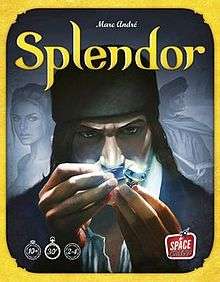Splendor (game)
Splendor is a multiplayer card-based board game, designed by Marc André and illustrated by Pascal Quidault, first published in 2014 by Space Cowboys, Asmodee. The board consists of cards laid out in a grid. Players are gem merchants of the Renaissance buying gem mines, transportation, and shops. The game was nominated for the 2014 Spiel des Jahres (Game of the Year).[1][2]
 Splendor box cover art | |
| Designer(s) | Marc André |
|---|---|
| Publisher(s) | Space Cowboys |
| Players | 2 to 4 |
| Playing time | 30 minutes |
| Skill(s) required | Resource management |
An expansion, Cities of Splendor, was released in 2017 with four included modules (The Cities, The Trading Posts, The Orient, The Strongholds).[3]
Gameplay
Splendor is an engine-building and resource management game in which two to four players compete to collect the most prestige points. The game uses the following:
- 40 gem tokens - seven each of emerald, sapphire, ruby, diamond, onyx, and five gold (wild). These are represented by poker-style chips.
- 90 development cards
- 10 Noble tiles
Each development card falls into one of three levels (•, ••, •••) indicating the difficulty of obtaining the gems required to purchase that card.
Every development card also is worth a particular gem (emerald, sapphire, ruby, diamond, or onyx), which may be used for future development card purchases.
Before the game begins, n+1 Noble tiles are dealt in the center, visible to the players, where n is the number of players. Four cards from each level (•, ••, •••) are dealt face up visible to the players, and the rest are kept in separate decks of their corresponding difficulty levels.
Turns
A player's turn consists of a single action, which must be one of the following:
- Take up to three gem tokens of different colors from the pool.
- Take two gem tokens of the same color (provided there are at least four tokens left of that color).
- Take one gold gem token and reserve one development card (if total number of reserved cards held by that player does not exceed three).
- Purchase a development card (from the table or the player's reserved cards) by spending the required gem tokens or/and using the value of the cards in your field of play.
After this action:
- If the player has earned enough development card gems to trigger a Noble points bonus, that player is "visited" by the Noble, and takes that Noble tile.
- If player is eligible for visit by more than one Noble, player can choose the Noble.
- Noble tile is not replaced by a new one.
- Player gets to keep the Noble until the end of the game.
- If player has more than 10 gems in possession, return few gems to limit total count of gems in your possession to 10 or lesser.
- If a development card is purchased, it is replaced from the top card on the respective deck. When the deck runs out, there are no more cards of that rank available.
End of game
When one player reaches 15 prestige points, the players continue playing the current round until each player has taken the same number of turns. Once this occurs, the game ends.
Scoring
Once the game ends, whoever has the most prestige points wins; in case of a tie, whoever purchased the fewest development cards wins. If this fails to break the tie, the players will then share the victory.[4]
Honors
- 2014 Dice Tower Gaming Awards Best Family Game Winner
- 2014 Golden Geek Best Board Game Artwork & Presentation Nominee
- 2014 Golden Geek Best Family Board Game Winner
- 2014 Golden Geek Board Game of the Year Winner[5]
- 2014 Spiel des Jahres Nominee[2]
- 2014 Tric Trac de Bronze
- 2014 Origins Game of the Year[5]
- 2015 Golden Geek Best Board Game App[6]
References
- "Splendor (2014)". BoardGameGeek. Retrieved 14 November 2015.
- Law, Keith (July 21, 2014). "Boardgame Review: Splendor". Paste Magazine. Retrieved November 14, 2015.
- Law, Keith (24 August 2017). "Gen Con 2017: The Best Games and More". Paste Magazine. Retrieved 24 November 2017.
- http://www.spacecowboys.fr/img/games/splendor/details/rules/Rules_Splendor_US.pdf
- Padla, Rei (July 10, 2015). "Be the best jewel trade merchant in 'Splendor' digital board game". Android Community. Retrieved November 23, 2018.
- Hall, Charlie (March 22, 2016). "The best board games of 2015, Board Game Geek's Golden Geek awards". Polygon. Retrieved October 8, 2018.